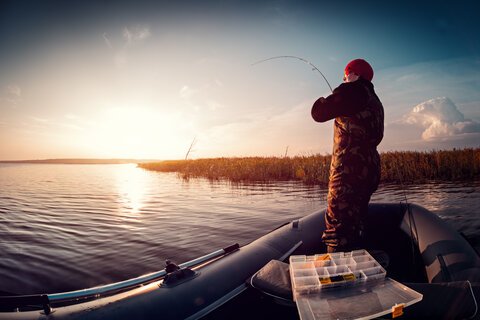If you're asking what a tackle box is, think of it as your portable fishing headquarters. Your fishing tackle box is basically your command center on the water.
New to fishing? Or, are you wondering how to organize a tackle box properly? We'll share top tips in the sections below.
What is a Tackle Box?
Simply put, a tackle box is portable storage for all your fishing gear. It keeps hooks, lures, line, and tools organized so you can find what you need without digging through a mess.
They come in different styles: hard-plastic boxes with compartments, soft tackle bags with pockets, or backpack systems. Our best advice? Pick what works for your types of fishing. Rusty hooks and tangled lines waste time and money!
What's in a Tackle Box: 7 Essential Items
So what's in a tackle box for successful fishing trips? Here are the can't-live-withouts:
1. Hooks in Multiple Sizes
You can't fish without hooks, so stock up on various hook sizes for different baits and species. Circle hooks are your go-to for live bait. J-hooks give you versatility for almost anything. And bring Trebel hooks if you're throwing hard baits.
2. Weights and Sinkers
You need weights and sinkers (also called terminal tackle) to make sure your bait gets deep enough to where the fish are eating. Fish don't always feed right at the surface!
3. Bobbers and Floats
Bobbers suspend your bait at the right depth and tell you when something bites! (If you're imagining a little white and red ball from the movies, you're correct!)
4. Assorted Lures
Your types of lures should match your target species. Soft plastics like worms catch everything. Crankbaits cover water fast. Spinnerbaits work in murky conditions, to name a few.
Don't go crazy - a few proven patterns beat dozens of unused lures taking up space!
5. Extra Fishing Line
Line breaks. So, keep a spare spool of your go-to line in the box or bag!
6. Pliers or Multi-Tools
You need pliers for removing hooks, cutting line, and crimping split shot. Needle-nose pliers reach deep into a fish's mouth safely. Some multi-tools include scissors for trimming soft bait.
If your pliers don't have cutters, pack dedicated scissors. You'll use them constantly for trimming knots and cutting fishing line.
7. First Aid Supplies
Unfortunately, hooks find skin eventually. Therefore, a small first aid kit with bandages, antiseptics, and tweezers belongs in every fishing tackle box. Throw in pain relievers too - headaches happen during long fishing trips!
How to Organize a Tackle Box
Good tackle storage starts with grouping similar items together.
- Keep all your hooks in one area, weights in another, lures separated by type.
- Use front pockets or smaller compartments for frequently used items like pliers and scissors.
- Larger compartments work for bulky lures or soft plastic bags.
- Label compartments if your box allows it. You will appreciate not having to search for the right hook size when fish are actively feeding.
And of course, keep your box organized by doing quick maintenance after each trip. Remove trash, check for rust, and restock what you used.
Different Storage Solutions for Different Anglers
Understanding what's in a tackle box helps you pick the right storage solution for your needs.
Hard tackle boxes offer maximum protection with fixed compartments. They're durable but can be heavy when fully loaded.
- Soft-tackle bags offer flexibility with adjustable dividers and multiple pockets. They're lighter and easier to carry long distances.
- Backpack systems work great for anglers who hike to fishing spots. Everything stays organized while keeping your hands free.
Learning how to organize a tackle box starts with picking the right storage style. Bank fishermen might prefer backpacks. While other anglers often stick with traditional hard boxes.
Tips for Keeping Your Fishing Tackle Box Ready
Check your tackle box before every trip. Nothing's worse than discovering you're out of the lure that's been working!
Rotate seasonal items. You don't need ice fishing jigs in July. Swap out tackle based on what you're targeting.
Additionally, you'll want to keep corrosion in check. Knowing how to organize a tackle box includes regular maintenance and cleaning! Saltwater anglers especially need to rinse and dry tackle after use. A little maintenance prevents expensive replacements!
Lastly, stock up during sales. Build your collection gradually instead of buying everything at once.
Bottom Line: What's in a Tackle Box
Knowing what a tackle box is and how to organize a tackle box doesn't mean you need every lure ever made. You just need the right basics organized so you can find them quickly!
The best fishing tackle box is the one that's organized, stocked with what you actually use, and ready to go when the fish are biting. Happy fishing!
Tackle Box Q&A
Q: What is a tackle box?
A: A tackle box is a portable storage container for fishing gear, keeping hooks, lures, line, and tools organized so anglers can access what they need quickly.
Q: What's in a tackle box?
A: A fishing tackle box typically includes hooks, weights, bobbers, assorted lures, extra fishing line, pliers or multi-tools, and a small first aid kit.
Q: How do you organize a tackle box?
A: Group similar items together: hooks in one compartment, lures by type, weights in another. Use smaller compartments or pockets for frequently used tools, label sections if possible, and perform regular maintenance after each trip.
Q: What are the best tackle box storage options?
A: Hard tackle boxes provide durable compartments, soft tackle bags offer flexible storage, and backpack systems are ideal for anglers hiking to remote spots. Choose based on your fishing style and mobility needs.
Q: Why is it important to keep your tackle box organized?
A: An organized tackle box saves time, protects your gear, reduces tangled lines, and ensures you have the right equipment on hand for successful fishing trips.

